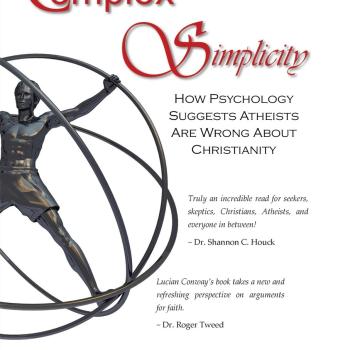
In 2019, researchers Perez and Vallieres conducted an in-depth study on the subject of deconversion. The two researchers identified three different areas in which doubts and objections blossomed, which ultimately led to deconversion.
The first of these areas was the mind. The potential deconvert began to find what they considered very reasonable objections to the facts about Christianity. What about all of the errors or contradictions in the Bible? What about the scientific evidence against Christian beliefs? What about philosophical arguments that show Christianity doesn’t work? These objections were based on what the researchers called “reason and enquiry.”
The second area was the heart. Here, the problems with Christianity seemed emotional and moral. What about Christian hypocrisy? Why would God allow all the evil in the world? Didn’t Christianity exclude certain people and limit personal freedoms? This, the researchers called “criticism and discontent.”
The final area was the life. Sometimes a person just matures and outgrows a belief. Sometimes a person moves on and no longer requires a religious crutch. Sometimes the church and the people within it have no more relevance to the former Christian. This the researchers called “personal development.”
The authors of this study note that over the history of religious psychology studies, significant attention has been given to the topic of religious conversion, however the body of work investigating religious deconversion is substantially lacking.
People change. Sometimes they enter religion, and sometimes they leave. The authors very reasonably wished to add information about how people leave religion to the very substantial work we have on how they enter religion.
Modern Trends
The researchers in this study begin by observing a new trend: religious following is trending downward, and atheism – never a particularly viable option in decades past – has been gaining steam as a vocal and influential subculture. This, the writers observe, can’t just be a social trend. Religious people are more likely to have and raise children than non-religious people (Perez & Vallieres, 2019). This increase in visible atheism must, in part, be due to an exodus which is occurring within the church itself. In fact, the authors state, the majority of people who currently claim to be atheists say they were raised as Christians (Perez & Vallieres, 2019). The question, then, is what kind of phenomenon is leading to this unprecedented exodus from – not just the church – but religion as an institution? The authors suggest that gaining an understanding of how and why individuals exit religion would fill in a substantial hole in the current understanding of psychology of religion.
This study seems accurate for several reasons. Firstly, independent research strongly supports this claim that religious participation is taking a nose dive (Pew Research Center, 2019). Whereas these surveys do not show atheism is big enough to be competition to religion, they do show that there is, nonetheless, a rise in atheism (though this is still sub-10%). Secondly, the biggest collection of research on religious conversion, The Oxford Handbook of Religious Conversion (Rambo & Farhadian, 2014), has dozens of chapters treating religious conversion from all possible angles, including neurological, sociological, psychological, and feminist issues, but only one chapter discussing religious deconversion, from studies mostly done in Europe, and most of them treating the movement of individuals between different religions rather than to an irreligious position such as atheism. This supports the authors’ claim that a hole appears to exist in the research regarding exit from religion. Finally, given the apparent rise in deconversion, it seems wise for the psychological community to take advantage of the abundant amount of data that a social trend like this supplies while it is still available.
Research
The two researchers found their subjects through an online forum called “The Clergy Project,” in which former ministers of every sort share the stories of their deconversions. Interviewing a variety of ex-Christians, the researchers identified the three domains of mind, heart, and life experience in which the deconversion took place.
The first of these was reason and enquiry. This began with what they call “nagging doubts” (p. 7) which led to questions. The questions were generally discouraged by the religious environment, or were given faith-based answers. The fact that these questions were not answered with logic or reason made the responses un-fulfilling and did not satisfy the questioners. The questioner would then begin to personally investigate the questions using critical thinking, and found much more intellectually satisfying answers outside the domain of religion.
This process seems to neatly mirror dissonance theory (Fiske & Taylor, 2017). Dissonance theory is the idea that two ideas held in tension (I want to believe/belief does not provide answers) are resolved when one of the ideas is selected and the other is discarded. The person then engages in selective perception (Fiske & Taylor, 2017) meaning that a person’s attitude will shape how they think. While convinced of religious, they saw the world through religious eyes, but when in doubt, they see the world with skepticism.
The second realm identified by the researchers was that of criticism and discontent. This differed from the first domain in that it focused on moral and emotional problems with the church rather than intellectual ones. The authors state that these moral and ethical objections experienced by the deconverts led to a feeling of isolation, detachment, and rejection (Perez & Vallieres, 2019). Whereas this realm has a different flavor than that of reason and enquiry, the same principles of dissonance theory apply.
The final realm identified by the researchers was that of personal development. In this realm, the participants said that religion was forcing them to refrain from growth, development, and personal fulfillment, and that exiting the church led to feelings of relief, freedom, empowerment, and self-expression (Perez & Vallieres, 2019, p. 9). Like the other two, this seems to agree with dissonance theory and behavior motivated by the desire to avoid dissonance – in this case, behaving as one wishes to behave rather than one is expected to behave by one’s community.
Discussion
Was this study addressing a valid concern? This is subject to debate. It was addressing a socially relevant concern because of modern religious trends. Religions rise and fall and people enter and exit religions regularly, but this formation of an atheist subculture composed of ex-Christians in the cultural West which is still significantly Christian (but increasingly less-so) is somewhat unique to this place and time in history. For Christians and other religious people, this trend is no doubt concerning, and such studies may serve religious efforts to save their institutions from extinction, but should psychology aid one or the other side in a culture war? In the interest of advancing psychology this is a valuable study. So if the pursuit of science for science’s sake is virtuous, it seems this study has merit.
That said, the findings were very consistent dissonance theory. If deconversion is a microcosm of dissonance and selective perception, then the study may be well-grounded.
Were the findings sound? As just mentioned, the findings of the study were very consistent with what has been studied, defined, and understood for decades in terms of attitude formation in general and dissonance theory.
Conclusion
Society is in a constant state of flux, with trends emerging and disappearing over generations, usually related to politics, culture, and/or religion. When such things occur, be they the “Red Scare,” the “hippy movement,” the “satanic panic,” or “New Atheism,” one finds that studying these trends tends to re-affirm what psychology had already discovered about human perception and behavior in the past. While each of these movements yield new data, and inform the psychological community of what form future trends may take, they generally strengthen existing models, and sometimes are helpful in weeding out unreliable models. The recent “deconstruction movement,” wherever it may ultimately lead, seems to strengthen the psychological community’s existing models of dissonance and selective perception among other things.
References
Crano, W. D., & Prislin, R. (2006). Attitudes and persuasion. Annual Review of Psychology, 57(1), 345–374. https://doi.org/10.1146/annurev.psych.57.102904.190034
Fiske, S. T., & Taylor, S. E. (2017). Social Cognition: From brains to culture. SAGE.
Perez, S., & Vallieres, F. (2019). How Do Religious People Become Atheists? Applying a Grounded Theory Approach to Propose a Model of Deconversion. Secularism and Nonreligion, 8, 3. DOI: http://doi.org/10.5334/snr.108
Pew Research Center’s Religion & Public Life Project. (2019). In U.S., Decline of Christianity Continues at Rapid Pace. [online] Available at: <https://www.pewforum.org/2019/10/17/in-u-s-decline-of-christianity-continues-at-rapid-pace/> [Accessed 30 November 2021].
Rambo, L. R., & Farhadian, C. E. (Eds.). (2014). The oxford handbook of religious conversion (Ser. [oxford handbooks]). Oxford University Press.













